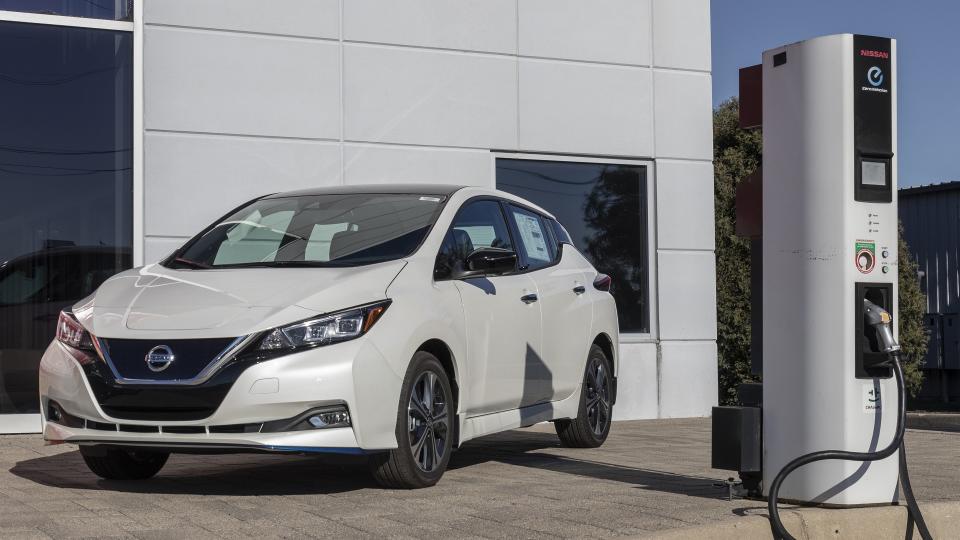4 Reasons Electric Cars Will Become Much More Affordable — But How Long Will It Take

Electric vehicle (EV) manufacturing has taken a hit this year. With sticker prices still out of reach for the average American, demand has led some car companies to slow production on models that were previously intended to flood the market.
See: Avoid 5 Electric Vehicles Likely To Break Down After 50,000 Miles
Find: How To Get Cash Back on Your Everyday Purchases
While some dreamers speculated that EVs could equal internal combustion engine vehicles in price by 2023, most experts are optimistically forecasting that the match will come in the mid-2020s, depending how certain factors continue to trend.
So, while several mid-range electrics have emerged over the past few years, like the Chevy Bolt, Nissan Leaf and Hyundai Kona EV, we’re probably still two to three years away from having a vast assortment of affordable electric models on the market.
Many companies have slashed prices on EVs this year, but that will only happen when those same companies figure out ways to make their models cheaper to produce and with cheaper components. But like all “newer” products, affordability will prevail once advancements in technology, economies of scale and government incentives improve over the next few years.
Here are some key factors contributing to the potential affordability of EVs:
1. The Cost of Batteries
The most significant factor affecting the cost of electric cars is the price of the battery. However, over the years, there has been a consistent trend of declining battery costs. And, as Goldman Sachs reported, battery prices should decrease by 40% by 2025. As technology improves and production scales up, the cost of manufacturing batteries is expected to decrease further and will directly contribute to lower overall vehicle costs.
Speaking to Business Insider, David Browne, the UK chief of EV manufacturer Smart, thinks “We’re only scratching the surface in battery development.” He added, “But battery technology is moving so quickly, and there are so many exciting developments, that there is lots we can do to improve efficiency.”
2. Policy Shifts and Incentives
Government incentives are already generous, but they alone haven’t been able to sway a significant number of drivers to switch over to electric. And they’re pointless if too many expensive models are over the $55,000 MSRP cost threshold ($80,000 for pickups and SUVs).
However, as far as the government and the auto industry is concerned, the future is electric and, as such, policies will continue to be tweaked in favor of drivers willing to taking the first step toward EV ownership.
3. Economies of Scale
According to Cox Automotive director Stephanie Valdez Streaty, the way through this current timid phase is to up production. “You have to get to a certain scale to really start to make money on electric cars and for the costs to go down,” she said. “You begin to see more innovation and improved efficiencies in the manufacturing process.”
Increased production leads to economies of scale, reducing manufacturing costs per unit. So, even though EVs are more expensive to produce than many expected, expanded production, and competition, should accelerate the adoption process eventually.
4. Expansion of Charging Stations
The expansion of charging infrastructure is crucial for the widespread adoption of electric vehicles. As charging infrastructure becomes more widespread and convenient, it can influence consumer confidence and push potential buyers to consider electric cars. In turn, increased demand will drive potentially lower costs.
More and more convenient stations will put less emphasis on manufacturers trying to increase their models’ ranges too. Tesla’s network is quickly becoming the industry standard, noted Business Insider. Both Ford and GM have committed to using Tesla’s superchargers starting in 2024, which should benefit automakers and drivers alike.
More From GOBankingRates
How Big Is the Average Social Security Check of a Middle-Class Retiree?
These 10 Cars Could Drain Your Savings Through Constant Repairs
This article originally appeared on GOBankingRates.com: 4 Reasons Electric Cars Will Become Much More Affordable — But How Long Will It Take

 Yahoo Finance
Yahoo Finance 